10 gardening goals – and how to make sure you achieve them
Scientific research has proved that if you write down specific gardening goals, you will get a better garden.
So I’ve researched the most popular goals for gardens today and looked at my own garden to come up with 8 gardening goals to transform your garden this year. And I’ve identified where to start or what is most likely to stop you achieving that goal.
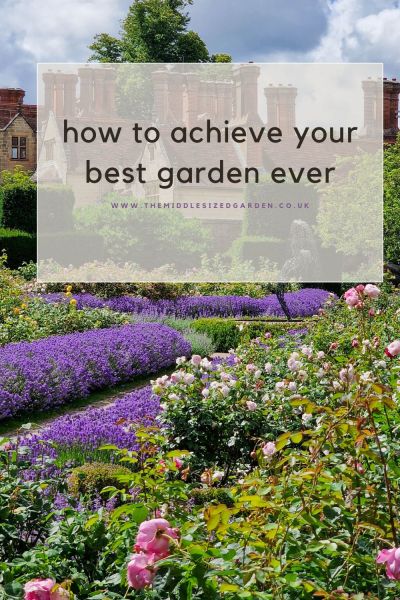
Are your gardening goals project-based or strategic?
The reason why writing your goals makes them easier to achieve is that the act of writing or speaking makes you clarify what you really want. Instead of vaguely thinking you must do better this year, you can identify either a project or a strategy.
Project-based gardening goals
- Start a compost heap
- Clear that forgotten corner of the garden – the one that’s turned into a dump
- Transform your garden from a family garden to a relaxing retreat – or the other way round
- Grow more veg
Strategic gardening goals
- Make the garden more wildlife friendly
- Make the garden more sustainable
- Make the garden easier to look after
- Save water in the garden
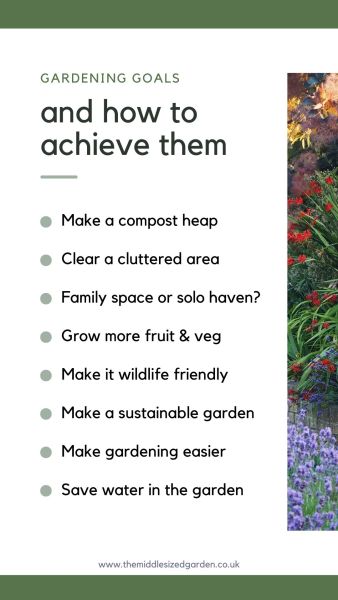
Writing down your gardening goals makes it more likely you’ll achieve them.
Project based gardening goals – Start a compost heap
This is one of the most common gardening goals. That’s because having a compost heap means fewer trips to the tip to dispose of garden clippings. And you can save money by using your own garden compost instead of buying well rotted manure and soil improver. A compost heap is one of the best things you can do for your garden.
What could stop you achieving success? Confusing information about composting.
People will tell you contradictory things. That’s because there are different ways of composting. There is easy composting (cold composting) and there is fast composting (known as hot composting).
You can find out how to do easy composting here. Essentially it means you throw in all garden clippings and raw fruit and veg peelings in. Add newspaper, grass clippings, cardboard and any other organic matter. You don’t need to worry about proportions and it’ll take about a year to break down before you can use it.
If you want lots of compost quickly, you’ll need to take more note of what you compost, you’ll need to turn it regularly and to chop the clippings up into small pieces. But you’ll get compost in just a few months. I don’t do fast composting myself, so I’d suggest buying Composting for Dummies to find out how to do it.
Find out more about which kind of composting is right for you in Do you want easy composting or fast composting?
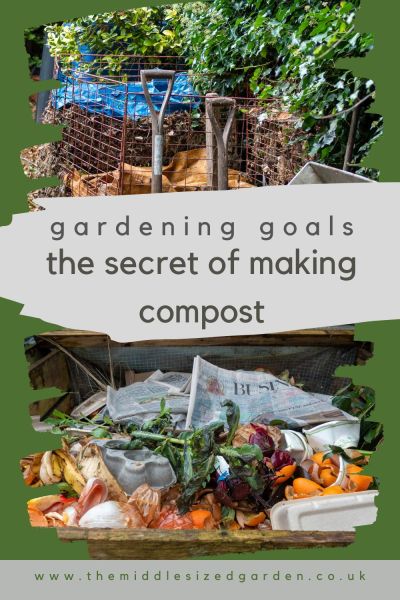
Compost is one of the most popular gardening goals, but there are a lot of myths about making compost.
Revamp a forgotten corner of the garden
We all have a part of the garden where we dump things. And that dumping ground can grow until the whole garden looks a mess.
What could stop you achieving success? Getting overwhelmed.
The way to start is to ‘chunk it down.’ I cleared a difficult shady corner in my own garden by dividing the job up into sections and doing one section at a time. So one day we would take everything that needed to be thrown away to the tip. Then next day we found places to keep what was left. And so on.
You can also ‘chunk it down’ by time. Set your alarm for 15 minutes and do exactly 15 minutes clearing. Then return for another 15 minutes later on or on another day. It’s extraordinarily effective. I’ve cleared a whole garage full of junk that way.
Most importantly, however, you need to decide what you want to do with the area once it is cleared. If you don’t, the dump will slowly return. Here are 10 options to transform a forgotten garden corner.
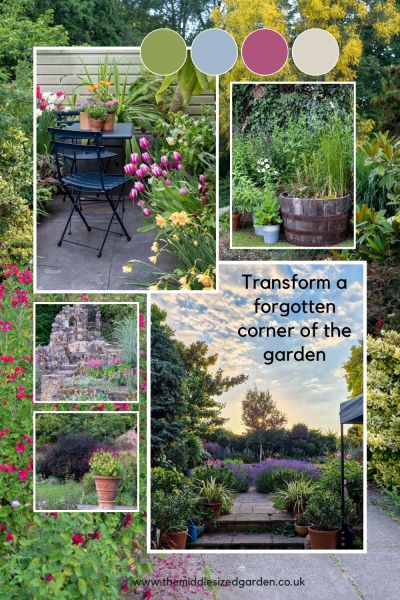
Decide what you want in that neglected corner of your garden.
Family garden or relaxing retreat?
This year’s gardening goals may be about updating your garden to fit in with your changing life. If you’ve recently started a family you may want to think about how to create a family garden.
But if your children are growing up, it may be time to create more of an adult relaxing retreat.
What could stop you achieving success? Not planning properly.
Even if you don’t want to make a big investment, you need to plan changes. Treat your garden as if it was new to you.
One of the best posts I’ve ever read on how to create a family friendly garden is by Matt Jackson here.
And if you no longer need a family garden because your children are now older, go back to the principles of garden design. List what you want to do in your garden. Think about what you want to see when you look out of the window or back at the house.
Here is how to design a garden if you’re not a garden designer from award-winning designer Pollyanna Wilkinson.
And see here for 5 top garden design tips and 2 mistakes to avoid from the famous garden designer Charlotte Rowe.
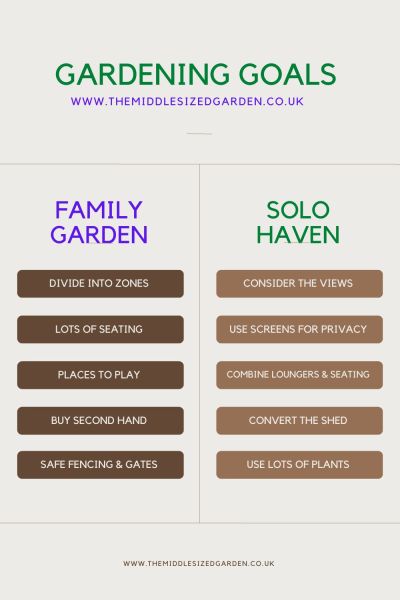
Do you want to turn your backyard garden into a family space or a solo haven?
Grow more fruit and vegetables
This has to be one of the most popular gardening goals ever. We all want to enjoy tasty fresh fruit and vegetables from our own garden. And some people make it look so easy!
But growing your own fruit and vegetables is a bigger commitment than growing flowers in an ornamental garden.
What could stop you achieving success? Lack of time.
Note that I have said ‘lack of time’ not ‘lack of space’ or ‘lack of knowledge’. You can grow fruit and vegetables on a balcony, as Jason Williams, The Cloud Gardener, has proved.
And there are many very good resources that will teach you how to grow fruit and veg. In terms of books, I can recommend Charles Dowding, Huw Richards, Grow Your Own Vegetables by Joy Larkcom and The RHS Step by Step Veg Patch by Lucy Chamberlain. One of those will suit your style of gardening. All have good factual information.
But be aware that growing your own fruit and veg means giving the garden almost daily attention. That doesn’t have to be a negative because some people find that 10 minutes in the veg patch after a day’s work is revitalising. And you can involve children too, so it can be done with family life.
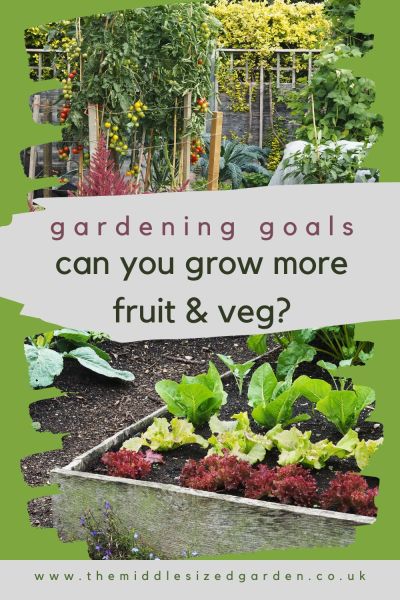
‘Grow more fruit & veg’ is one of the most popular gardening goals – what would stop you achieving it?
Strategic gardening goals – make your garden more wildlife friendly
The strategic gardening goals I’ve listed blend into each other to some extent. A wildlife friendly garden is more sustainable, for example. And a sustainable garden saves water.
The key to making your garden more wildlife friendly is to stop using pesticides and weed killers. And try to provide the four key elements: access, shelter, food and water. Find out more in this post here on what a wildlife garden really needs.
What could stop you achieving success? Worrying about slug, snail or insect damage to plants.
It’s well known that people see criticism more than they see compliments. If two people compliment you and one says something critical, it will be the negative one you remember.
It’s the same in the garden. Your friends will see the beautiful flowers, trees and shrubs in your garden. You will see the nibbled hosta leaves and the aphids on the roses. But, as Neil Miller says in Growing Roses – Expert Tips, most aphids on roses will quickly be eaten by birds and other predators if you run a wildlife friendly garden. Just keep your nerve and stay away from the pesticides.
I tried this out when my favourite dahlia was covered with aphids. I did nothing and the aphids were gone in 3 weeks. See how to keep dahlias free of earwigs, slugs and snails without chemicals.
Getting the right balance of wildlife to pests does take a little time and it will never be perfect. You’ll have to tolerate some damage. But it’s a lot easier and cheaper than spraying everything.
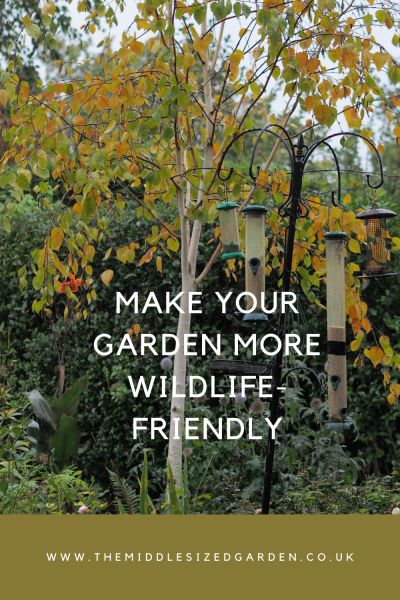
The four key features of a wildlife garden are shelter, access, food and water.
Make your garden more sustainable
A sustainable garden is wildlife friendly, cheaper, easier to run and it won’t use as much water, so in many ways this category of gardening goals overlaps with all the other strategic goals.
The most sustainable garden I know is Stephen Ryan’s. Stephen runs The Horti-Culturalists YouTube channel. He often says that ‘nothing ever leaves his garden.’
What could stop you achieving success? Pinning everything on one element of sustainability
Sustainable gardening is a huge topic. It’s easier to understand if you break it down into component parts.
Sustainable gardening techniques include saving water, using organic fertilisers (such as home-made fertilisers made from nettles or comfrey), limiting how much hard landscaping you have, using peat-free composts, conserving water and using mulch to suppress weeds.
It is easier to get to grips with one element at a time. But never lose sight of the fact that it is only one element, not the complete answer.
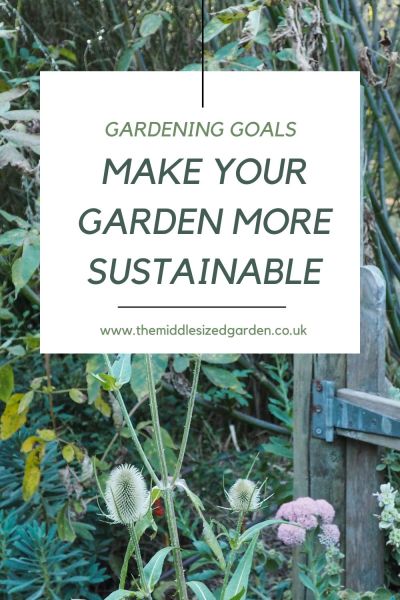
Make your garden more sustainable – but don’t get too hooked on just one solution.
Can you have a sustainable lawn, for example?
For example, lawns have become the focus of sustainability arguments. Anti-lawn campaigners say that the use of petrol mowers, chemical fertilisers and weed killers plus watering make lawns unsustainable in today’s gardening. The words ‘green desert’ are used.
However, as David Hedges-Gower of the Lawn Association points out, lawn grasses are plants. And the most sustainable thing you can do to any garden is fill it with as many plants as possible. Lawns absorb heat, pollution and carbon dioxide. They benefit bio-diversity because birds feed off the worms. And when flowers break through, pollinators enjoy them.
The key to the lawn debate is knowing how the arguments apply to where you live and your lifestyle. If you live somewhere where there are no native lawn grasses and you need to water and fertilise your lawn constantly, then traditional lawns are not sustainable.
If you live somewhere (such as the UK and many other places) with native lawn grasses and a reasonable level of rainfall, then a lawn is probably the most sustainable way of covering a large area in your garden. Reduce your use of fertilisers and pesticides and allow some of the lawn to grow long or mow it less often to make it more sustainable. And don’t water a lawn once it is established. It will go brown and dormant, but it is not dying. It will revive when the rains come.
Artificial grass is never sustainable. It uses petrochemicals in its manufacture, gets too hot in direct sunlight, prevents wildlife from using the soil and needs cleaning so you will have to use water on it in a drought. It also lasts for a relatively short time (around 10 years) and cannot be recycled. And it’s expensive, especially compared to a bag of lawn seed.
To find out more read ‘Do you really need a perfect lawn and is it sustainable?’
Make your garden easier to look after
Garden lovers can be sniffy about the low maintenance garden. But if you are short of time or struggling with health problems, you will enjoy your garden more if it is easier to look after.
What could stop you achieving success? Feeling guilty that you ‘should’ be doing more gardening
I have a friend who says that the word ‘should’ should be abolished! You really don’t have to do all the jobs on the ‘gardening to-do lists.’ I sometimes list things you don’t have to do on this blog, such as What Not To Do in the Winter Garden.
You can cut down on weeding and digging in the garden by going No Dig (see No Dig for Flower Gardens).
Choose easy care shrubs and perennials instead of filling your garden with annuals. Holiday rentals need easy-care gardens because people on holiday don’t want a gardener in their garden, so check out these 10 low maintenance plants which garden designer Posy Gentles installed in the Chimney Farm Barns luxury holiday self catering complex.
And here are more low maintenance plants for beautiful gardens.
Pots are more work than borders, but if you put low maintenance shrubs and grasses in pots, you won’t have to deadhead them or change them over with the seasons. They’ll last for years with regular watering and some fertiliser in the summer.
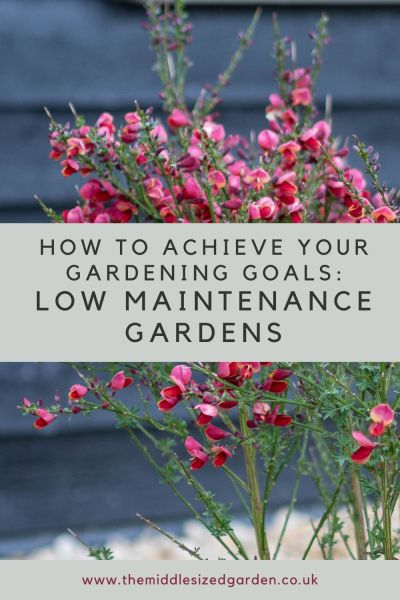
Low maintenance plants can be pretty as well as easy care.
Save water in the garden
In the UK and other parts of the world, last summer was exceptionally hot and dry. So we’re all thinking about drought tolerant plants. However, we could easily get an exceptionally wet summer, so look for resilient plants or drought tolerant plants that won’t mind if it rains.
What could stop you achieving success? Thinking that installing a water butt/rain barrel is the answer
As soon as you read the words ‘save water in the garden’, you will be advised to ‘get a water butt (rain barrel).’ A water butt/rain barrel is a good idea, but it will only hold a few days water. Get the largest one you can fit in, and preferably get 2 or 3 which connect to each other.
If you have the space, you could consider a rainwater harvesting system, filled by re-routing the rainwater from your gutters. In a small wildlife garden for a town, Anne Vincent created a large pond in her garden by re-routing her rainwater in this way.
If plants need watering, water thoroughly but less often. Garden writer Christine Walkden only waters her plants twice a week, even in very dry weather. But she uses up to a whole watering can per plant (depending on the size of the plant), directed to the soil around their roots. Do the same with pots.
Don’t sprinkle water on leaves, don’t use sprinklers and never water lawns, except in their first year.
And look at drought tolerant garden styles, such as a rock garden (for a slope) or a dry garden, like this one at Beth Chatto Gardens.
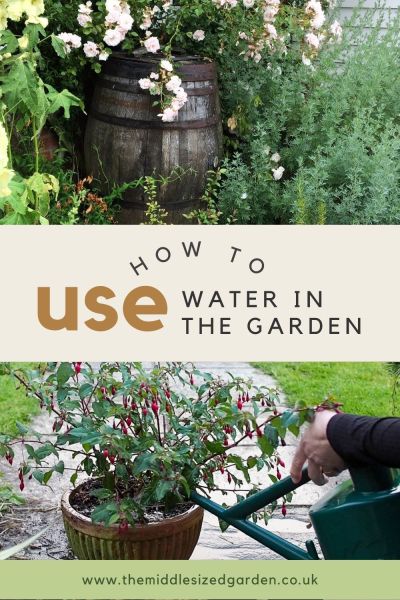
A water butt is a useful thing to have, but it’s never the complete answer to saving water in the garden!
Pin to remember how to succeed at your gardening goals
And do join us for a free weekly email with more tips, ideas and inspiration for your garden. Sign up here.
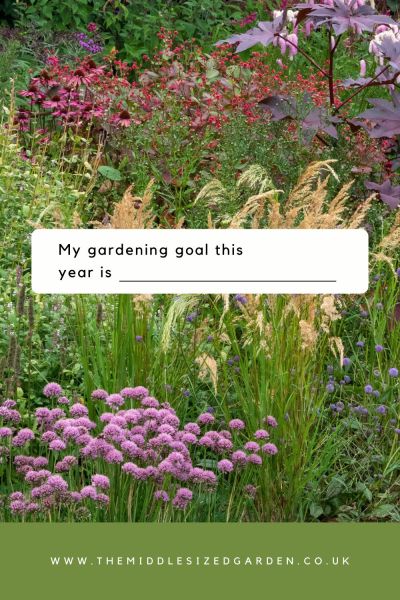
























My gardening goal for this year is to become a person who spends half an hour in the garden every day.
Great goal!
Hi…. we would love to have more birds in our garden but we have cats and we feed some community cats… any way we can safely attract the birds?
This is an interesting dilemma, and we have it ourselves up to a point, so I have been thinking about it. Firstly, position bird feeders close to shelter. This is a tip from Joel Ashton in Wildlife Friendly Garden tips: /5-easy-wildlife-garden-tips-really-make-difference/ Cats aren’t the only predators – many garden birds are killed by larger birds, such as sparrowhawks. So if there is a thick hedge near the feeders, then small birds can fly into it away from both the hawks and the cats. I also think it helps to have more than one feeding station, because it means predators have to monitor two or more sites. And I think that it’s important to carry on supporting the smaller birds because if people don’t put out feeders for fear of predators, then there will be a limited number of feeders in the area. Which means the predators will always know exactly where to go! The more food and water sites there are, the more choice the birds have for safety. And perhaps it’s also important not to worry too much about it – the stronger, younger birds will escape the cats/hawks and it would be a shame to stop feeding all birds just because you’re worried about one or two being killed. The other thing you can do is plant bird friendly plants, with fruit, berries and seeds. But the same rules apply – lots of choice to have safety in numbers and make sure there is a hawk-proof, cat proof hedge or similar nearby. Good luck!